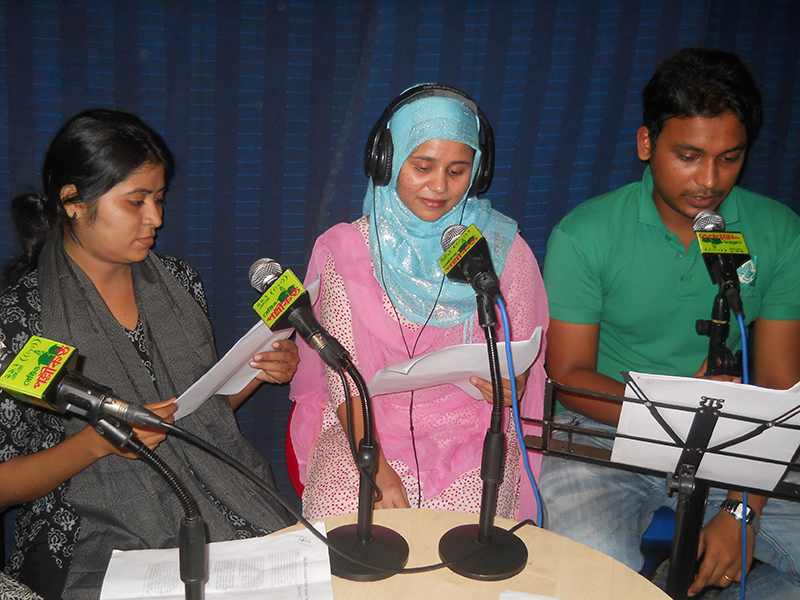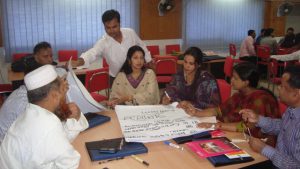Basic Information:
The biggest challenges that women and girls face are related to the attitudes, practices and ideologies that are deeply rooted in the traditions and social norms of our country. Media can play an outstanding role to influence these drives for bringing positive changes. It is very crucial, particularly in rural and remote areas where the majority of the population are being illiterate and have no access of media of their own, community radios can be considered as the only media that is being treated as affordable, low cost and the only source of information. Keeping this in mind, Bangladesh NGOs Network for Radio and Communication (BNNRC) has taken initiative to launch a project, “Girl Power Project (GPP)” to sensitize and further activate the media people (initiators of media houses and practitioners) to contribute to eliminate the violence against girls and young women through media. This 5-year long project (from 2011-2015) had been implemented in collaboration with Plan International Bangladesh and other nine partner organizations (national Non-Government Organizations) in Bangladesh
A large number of journalists especially the rural Community Radio Broadcasters as well as other local media practitioners (particularly in rural areas) are not properly aware about the adverse effect of violation of right based issues on gender, women empowerment, child protection etc. As a result, one of the most important causes among lot of factors is lack of professional skills and understanding of media journalists and broadcasters to cover these issues in media. Therefore, the project was targeted to build capacity and improve understanding of the broadcasters and practitioners working in Community Radio Stations (CRSs) coverage areas in Bangladesh. This has aimed to ensure the wider coverage of the issue to create a solid impact in changing the traditional mindset towards girls and women among the communities.
Project description
 The most important project activity of GPP was to improve the understanding and capacity of the media broadcasters and journalists on reducing gender based violence with other child and gender-focused right based issues. Under this activity GPP, BNNRC has trained more than 350 Community Radio Broadcasters and mainstream media practitioners (both print and electronic) at national and regional level to highlight gender based violence as well as other child and gender-focused right based issues in their reports.
The most important project activity of GPP was to improve the understanding and capacity of the media broadcasters and journalists on reducing gender based violence with other child and gender-focused right based issues. Under this activity GPP, BNNRC has trained more than 350 Community Radio Broadcasters and mainstream media practitioners (both print and electronic) at national and regional level to highlight gender based violence as well as other child and gender-focused right based issues in their reports.
More than 500 motivated CR Broadcasters and other mainstream media practitioners (both print and electronic) were engaged to make more quality radio and TV programs, reports and news through their own media channels. 3 awarding events were organized for their best reporting and programs. As a result, wider audience approximately 5.6 million listeners of the target areas (CR Station coverage areas) better informed through regular interactive radio programs on gender equality, women’s and child rights and protection against violence. For example, through Community Radio Padma (located in northern district Rajshahi) had broadcasted more than 132 radio episodes on the concerned issues during the project period.
The sensitized other Community Radio Broadcasters of other CRSs were inspired to motivate their senior management committee members to give emphasis on this issue. As a result since 2013, all 17 CRSs had increased their schedule programs on women, children and gender issues. Under this project, a total of seven (07) radio and TV programs had broadcast/telecast through Bangladesh Television, two commercial TV (NTV and Boishakhi TV Channel) and Bangladesh Betar during 2011 to 2015.
“We want to listen this type of exceptional but informative radio program ‘AsharAlo’. (a weekly radio program). We think, the local communities should know the various essential information or issues related to gender based violence at their local areas through this entertaining way,” told Ms. Nodi, 35, a member of a Radio Listener Club, Pabohati, Jhenaidah. She shared her feelings during conduction of a Vox-PoP of a program under this project. “Most of the members of the radio listener club of Pabohati, Jhenaidah have enjoyed listening magazine programs and have expressed their joy to find their near and dear one as a performer of this type of radio programs”, she added.
Examples of linkages between the WSIS Action Line and the SDGs
 All the activities including mission of BNNRC has focused to contribute to several international mandates, including Poverty Reduction Strategy Papers (PRSPs), the World Summit on the Information Society (WSIS) action plan, and the Sustainable Development Goals (SDGs). As far as we concerned that the Sustainable Development Goals has placed gender equality and women’s empowerment (SDG 5) at the heart of its efforts to accelerate progress towards the SDGs.This project also addresses the Action Line C 3 (Access to Information and knowledge) in WSIS.
All the activities including mission of BNNRC has focused to contribute to several international mandates, including Poverty Reduction Strategy Papers (PRSPs), the World Summit on the Information Society (WSIS) action plan, and the Sustainable Development Goals (SDGs). As far as we concerned that the Sustainable Development Goals has placed gender equality and women’s empowerment (SDG 5) at the heart of its efforts to accelerate progress towards the SDGs.This project also addresses the Action Line C 3 (Access to Information and knowledge) in WSIS.
Community Radio as an alternative media upholds the access to information of grass-root people in our society. Community Radio has created scope for the poor and marginalized community to raise their own voice for the voiceless. This neo-media outlet opened scope to establish their rights of information and communication in social, political, cultural and environmental area. In line with the United Nations SDGs, by increasing the accessibility of information for poor and vulnerable prisoners as well grass-root people we can achieve the following objectives:
SDGs 16.3-Promote the rule of law at the national and international levels and ensure equal access to justice for all: The participation of poor justice seekers in media is an agenda for aiming access to justice for all, reduction of social inequality and to make easy their access to information.
SDGs 16.6- Develop effective, accountable and transparent institutions at all levels: Through the program creating a Community dialogue among local government and law enforcement officials, development workers, journalists, members of civil society and community people.
SDGs 16.10- Ensure public access to information and protect fundamental freedoms, in accordance with national legislation and international agreements: The program contribute in community access to information by using the direct media. Approximately 30% radio programs had been broadcast with the active participations of rural marginalized communities including dalit (out-cast) communities.
Highlights of the project’s partnership activities
After this project, the partners CSOs of BNNRC (the 17 CR Stations) are still continuing to produce and broadcast radio programs on relevant issues and exchange their best practices in this regard. They are continuously exchanging their best practices and skills and providing their inputs in further knowledge generation, policy guidance and capacity building activities in CR coverage areas. A good network is being established with the other nine (9) implementing partners of this project besides the 17 Community Radio Stations too .
Challenges and future perspectives for the project
- High migration of the CR staffs, all the CRSs need continuous capacity building supports, otherwise the quality programs on this issue will be challenged. The program broadcasters need to be used various sources during script writing of the programs. So, they need to be updated on content development as well as trained in gender responsive communication.
- Conduction of research and findings especially on the audience feedbacks of the broadcasted programs are being limited and somewhere in absent too.
- The action plans committed by the media practitioners during training/workshops need to be followed up.
- Awarding the media practitioners on frequent basis will motivate them to work on CP, CR and gender issues.
- Engaging male media practitioners in the programs can draw more attention in sensitization of wider audience of any media.
- Formation of a Bangladesh Girl Power Alliance (BGPA) Club will be a permanent platform of all members. So, BGPA needs to be promoted at its initial 2 to 3 years to ensure their sustainable position.
Views on WSIS Stocktaking and Prizes contest
WSIS Stocktaking and Prize will be an inspiring model to the community media practitioners in different parts of the world. The winning of the prize will be inspiring to our future broadcasters and policy-makers. In long run, these broadcasters will be developed as brand ambassadors of community radio, form networks and thus women leadership will be established at local media sector of Bangladesh.
About: BNNRC
Bangladesh NGOs Network for Radio and Communication represents the community media sector to Government, Industry, Regulatory Bodies, Media and Development Partners.
BNNRC has been struggling for the last 17 years to open up the community media (including Community Radio, Community Television) and giving focus on its vital role as voices of the voiceless rural people. The reality of today is that the bondage between the community people and local-level community radio stations are getting strengthened day-by-day. Community Radio has now become their part of life and livelihood.


